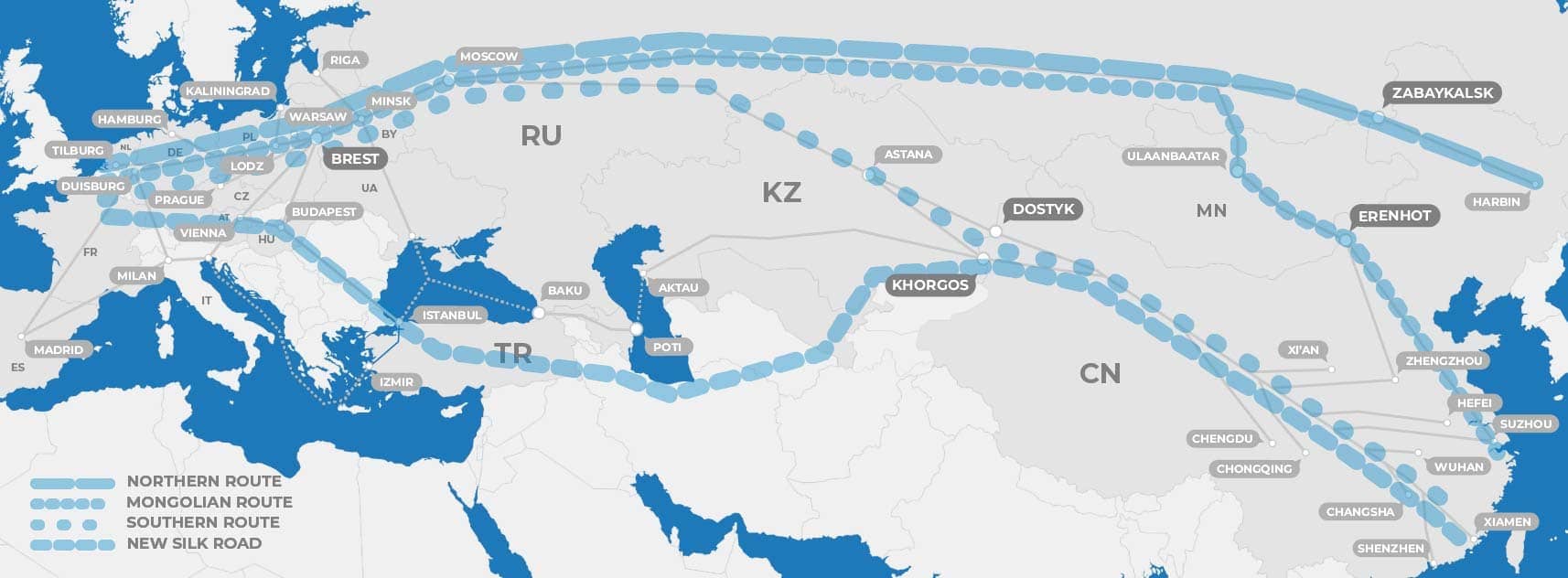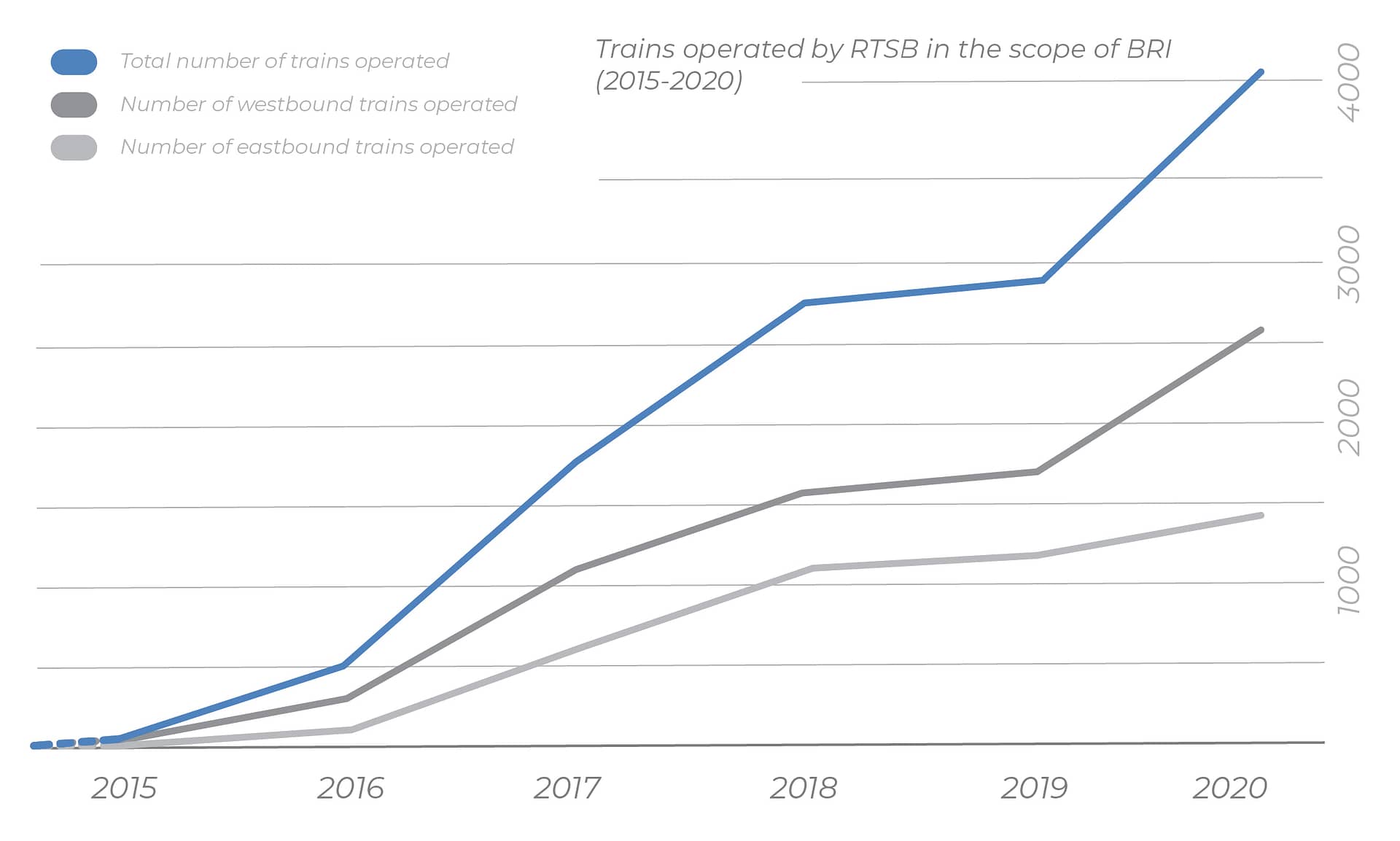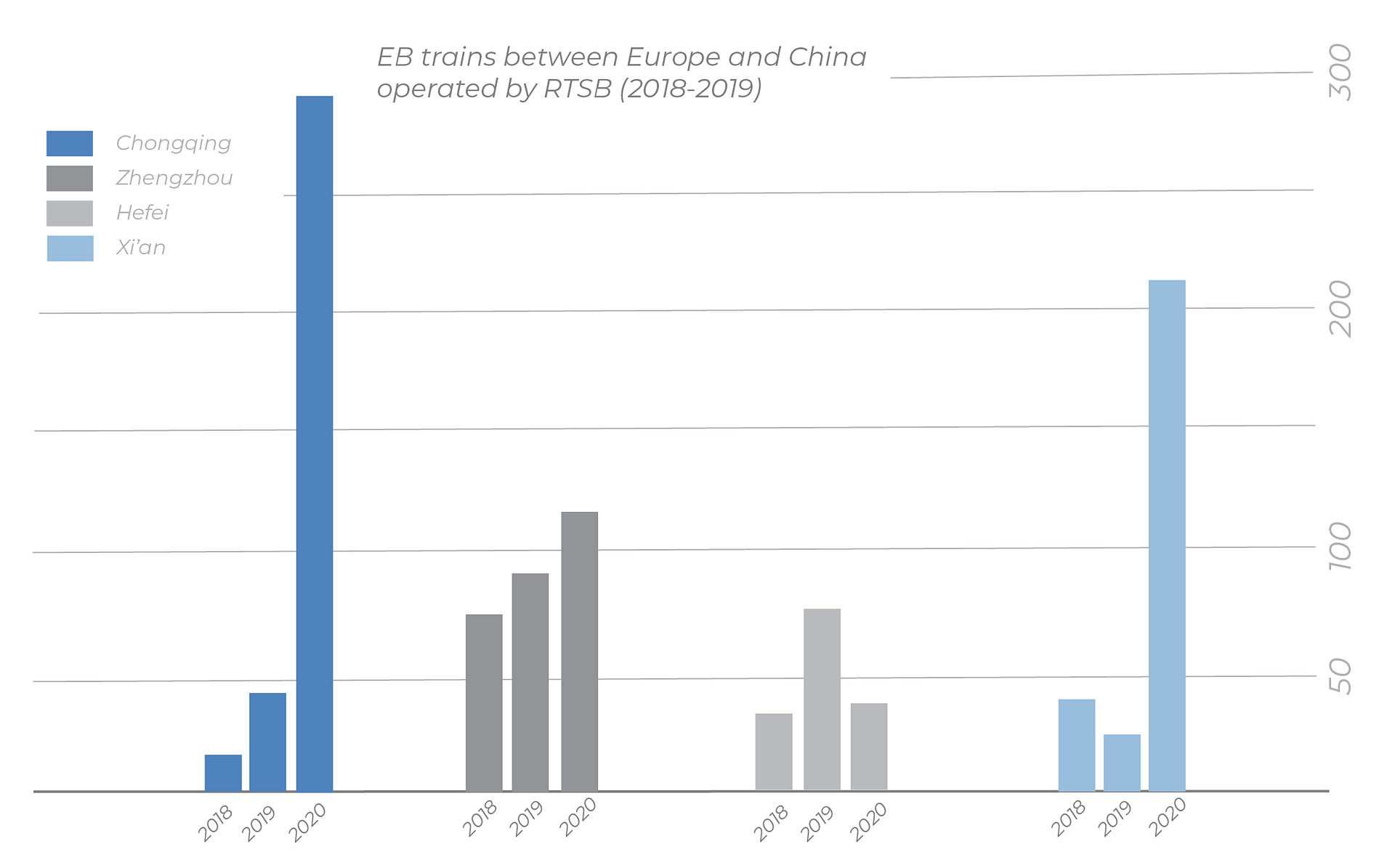Explained
THE BELT AND ROAD INITIATIVE
The Belt and Road Initiative is an ambitious infrastructure program instigated by the Chinese government in 2013, aiming at boosting connectivity and commerce across Eurasian trade corridors. Proclaimed long term goal is the cooperation among participating countries in the areas of policy, infrastructure, trade, finance and interpersonal ties. Besides massive investments in new roads, rail lines, ports and pipelines along the land-based Economic Belt as well as the sea-based Maritime Road, the initiative includes subsidies on shipping products from China to foreign markets with a planned investment of as much as USD 1 Trillion by 2027.

The Belt and Road Initiative – Trans-Eurasian Railway Routes
In response to the BRI, the European Union has developed its own concepts for developing connectivity between Asia and Europe:
Konnektivitätsstrategie
With the “Konnektivitätsstrategie” the EU promotes connectivity in the areas of transport, IT (digital), energy and civil society. The declared goals are the creation of free, undistorted competition (“level playing field”), transparency, sustainability (emission reduction, market efficiency, financing) and the acceptance of internationally recognized rules.
TEN-T Policy
The goal of the EU’s TEN-T policy is to build up a comprehensive multimodal transport network that should give all regions better access to the European and global market. The EU not only pursues the goal of achieving harmonized infrastructure planning in the member states, but is also interested in a high level of connectivity with structures in the neighboring countries, particularly with a view to the Eurasian land bridge, which could intensify trade between Europe and Asia through the expansion of rail networks
Western Balkan Plan
The adoption of a multi-annual EU action plan for the development of the regional economic area of the Western Balkan, which the heads of state and government of the Western Balkans agreed on in July 2017, is another promising step: the implementation of the action plan will not only serve to further intensify trade, investment and mobility within the region as well as between the region and the EU, but also to contribute to the integration of the markets in European and worldwide value chains.
Total number of trains:
- 2015: 46 trains
- 2016: 531 trains
- 2017: 1806 trains
- 2018: 2785 trains
- 2019: 2968 trains
- 2020: 4016 trains
WB trains:
- 2015: 33 trains
- 2016: 353 trains
- 2017: 1127 trains
- 2018: 1624 trains
- 2019: 1758 trains
- 2020: 2647 trains
EB trains:
- 2015: 13 trains
- 2016: 178 trains
- 2017: 679 trains
- 2018: 1161 trains
- 2019: 1210 trains
- 2020: 1369 trains
BRI – OUR ROLE
COLLABORATION AND CONTRIBUTION
While the Belt and Road Initiative is proclaimed to be a win-win agreement for all states involved, there are several challenges to overcome in order to reach overall long term sustainability on all ends of the program, especially regarding competitive unsubsidized shipping rates for rail transportation compared to other shipping modes.
NETWORK
We are proud to work closely with the Chinese State Railway and platform companies and have strong ties to state railways along the Eurasian Corridor. Our solid network of partners paired with our extensive experience in rail transportation allows us to optimize existing transportation chains aiming at a higher cost efficiency in shipping processes in order to lower overall shipping costs and transit times.

Together with our partners we were able to reduce
transit times on major routes by up to 5 days in the past year.
ROUTES
In cooperation with Belintertrans we operate trains along the Mongolian and Southern route to/ from Europe and China via Ulaanbataar and Khorgos/ Dostyk.
In the course of an increasing demand for rail transportation we are proud to offer train connections on alternative routes, crossing borders in the Grodno region (Belarus) and Kaliningrad (Russia).
It has always been our main goal to link the European hinterland to the main corridors to give those regions better access to rail transportation to and from the CIS countries and China. With our hub-strategy we connect cities like Hamburg, Duisburg, Tilburg, Milan, Madrid, Budapest, Wien, etc. via public trains to the main hub in Malascewicze, opening up the Eurasian rail corridor to those smaller hinterland hubs.
Belt and Road
TIMELINE
2014
First “Silk Train” between Poti and Baku operated
The project „SILK TRAIN POTI-BAKU“ is resumed in July 2014 to create a cost effective and fast rail route, connecting Europe and China.
Our subsidiary Intermodtrans GmbH becomes official operator on this relation and runs the first block train between Poti and Baku.
2015
First intermodal container transport from China to Turkey
RTSB operates the first intermodal container transport from Chengdu to Istanbul along the new silk route. Containers are railed from Chengdu via Dostyk to Aktau, then shipped over the Caspian Sea to Baku to be loaded on the Silk Train to Poti, traversing three Central Asian countries – Kazakhstan, Azerbaijan, and Georgia. In Poti the shipment goes on the last mile to Istanbul on container trucks.
2018
First trains run through alternative border crossings
RTSB starts using alternative border crossings to relieve the main corridor Brest – Terespol. The crossings Bruzgi – Kuznica between Belarus and Poland and Mamonovo – Brzniewo between Kaliningrad and Poland prove to be successful alternatives matching transit times on the main corridor.
Kaliningrad offers access to the short sea for connections to European and Scandinavian ports, making it an attractive multimodal solution, as well.
2019
Regular express train link through Kaliningrad established
The first regular express trains to Neuss run through Kaliningrad with a transit time of only 10 days.
Siemianówka – Svisloch is used as another alternative border crossing between Belarus and Poland for the first time on the eastbound relation Bremerhaven – Chengdu.
New destinations:
| Wroclaw | Poznan |
| Luxemburg | Neuss |
| Zodino | Lesosibirsk |
| Krasnojarsk | Goryn |
| Tobolsk | Bremerhaven |
| Milan | Budapest |
2020
New destinations in the European hinterland develop
New destinations:
| Liège | Ludwigshafen |
| Svetlogorsk | Castolovice |
| Frenkendorf | Vilnius |
| Niederglatt |
PUBLIC RELATIONS
Come visit us at one of our international expos or forums:
RTSB has been working continuously on promoting the Belt and Road program by creating awareness and advertising the product ‘railway transportation’ in general to customers and partners in Germany and Europe wide. Due to a lack of knowledge and trust in the product, many potential customers still don’t see rail freight as a favorable option to sea and air freight.
In order to achieve sustainability of the initiative it is vital to avoid empty returns of container trains by not only importing products from China, but also increasing the export of European products to Central and South East Asia by rail. Ever since our first involvement in the BRI we have been working with transportation companies and state railways, closely, communicating the benefits of rail freight, pushing to reach capacity on round trips and optimizing overall transportation processes resulting in a higher cost efficiency and thus getting closer to becoming independent of Chinese subsidies.
IT APPLICATION
Lastly, our exclusive IT application myTransoffice offers transportation companies along the Economic Belt attractive features like DMS (Document Management System) and Track & Trace giving them full insight on every detail of their shipment and simplifying processes at the borders as well as during intermodal interchange. MyTransoffice is designed to build an information bridge across geographic regions, languages, currencies and business units.
Platform companies in Hefei and Chengdu as well as the customs operations in Brest are working with our system linking processes and easing procedures within transportation chains.

